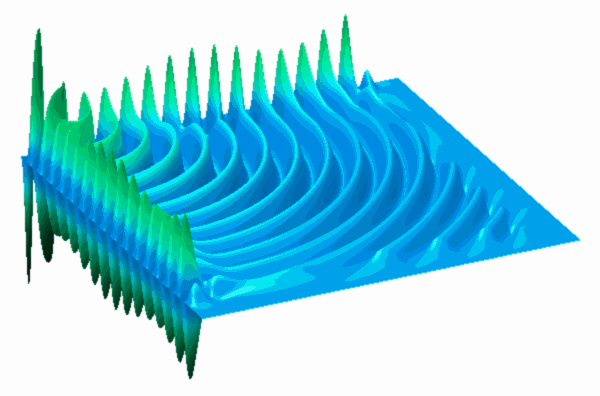
The wavefunction is a fundamental concept in quantum mechanics, telling us where we're likely to find a particle—the position or momentum of an electron, for example—even though its physical meaning is rather unclear. This concept has turned out to be extremely useful.
Where the wavefunction really counts is in things like molecules, where it determines properties like structure and behavior. Yet determining the spatial properties of the wavefunction inside something like a molecule is not something that is easily done. That is what makes a paper on imaging the wavefunction of an ionized, vibrating hydrogen molecule so interesting.
The challenge with measuring the wavefunction of a molecule when it is vibrating is that it is not enough to figure out where the electrons are; you also need to make a precise measurement of where the atomic nuclei are spending their time as well. To make matters worse, this all has to be done one molecule at a time, because otherwise you just get the average of where the nuclei are, which is not much different from getting nothing at all.
Blowing up molecular hydrogen
So that's the challenge. How did the researchers from Germany meet this challenge? With a clever combination of experimental work, calculation, and a really good choice of molecule. The molecule the researchers chose to study was ionized hydrogen, which is two hydrogen nuclei with only a single electron shared between them. This very simple molecule is perfect because all its states can be calculated, and the potentials (the electric fields that hold the molecule together) are all known.
Some of those potentials are binding—that is, they hold the hydrogen molecule together— while others are not. Any hydrogen molecule is, by definition, sitting at a binding potential. If we force it suddenly into a non-binding potential, it will no longer be a molecule—it will explode as the positively charged nuclei drive each other apart. By measuring the final kinetic energy of the two nuclei, we can calculate back to where the atomic nuclei must have been when the transition took place.
To put it in blunt terms: the researcher blew the last remaining electron off the molecule, and watched it explode.
These sorts of measurements have been around for a while. But the key difference here is their accuracy and the knowledge they provide about the starting conditions. The researchers were able to measure the kinetic energy of the nuclei with enough accuracy that they could back calculate to figure out where the nuclei must have started from.
Incredible as that is, there is more. We know the exact potential and vibrational states of molecular hydrogen. By repeating the measurement many times, the researchers could figure out where the nuclei spent most of their time relative to each other, which is, essentially, the wavefunction of the vibrational states of the hydrogen molecule.
To show this, the researchers deliberately excited hydrogen molecules into different vibrational states and then measured the wavefunction, showing that it corresponded quite nicely to the theoretical predictions—well, for the groundstate at least.
Too much excitement
For the excited states, though, things seemed to go horribly wrong. The problem, it seems, lies in the back calculation to the starting position. That calculation assumes that the nuclei explode from a standing start. But, by definition, in an excited vibrational state, the nuclei are moving most of the time. The researchers attempted to correct for this by using a technique that estimated the initial kinetic energy of the nuclei, but that didn't agree with theory either.
In a move that is as dodgy as can be (but entirely understandable) the researchers then averaged the two calculations to get a great fit to the theory. Obviously, describing this as dodgy is overstating the case, because the approach can be justified. But my first reaction to that part of the paper was very cynical. Essentially, the two calculations are two extremes: nuclei starting from rest and nuclei at near maximum velocity. In the end, though, averaging these two cases is probably the only way to get a realistic starting point for the calculation.
One of the cool things in this experiment is that you can clearly see the quantum mechanical nature of the motion of the nuclei. Classically, when a molecule is set vibrating, you can think of it as a mass-and-spring system, where the nuclei swing back and forth, moving very fast through the center, and slowly at the extremes. If this were the case, then these experiments would have often found the nuclei at the edges of their motion and rarely in the middle. Most importantly, because the nuclei spend a bit of time everywhere, the distribution of their locations should have been smooth.
In quantum mechanics, things are different. The wave function—and hence the probability of finding a nuclei—goes to zero in a periodic fashion, so there are some places that a nuclei should never be found. The researchers do observe this, and that is very cool.
In the beginning of this article, I waxed lyrical about the importance of the wavefunction, and how, if we only had a picture of it, we would understand everything. So the obvious question is: how applicable is this technique to more useful molecules? The answer is, unfortunately, not very. The reason it worked in this case is that there is just a single electron to remove to get an explosion. And to make matters easier, all the states are known already. I think it would be very difficult to apply this to more complicated molecules, where none of this is true.
Physical Review Letters, 2012, DOI: 10.1103/PhysRevLett.108.073202 (About DOIs).
Listing image by Photograph by lbl.gov
reader comments
21